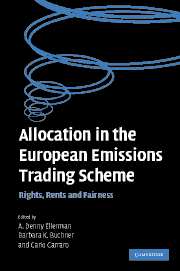Book contents
- Frontmatter
- Contents
- List of figures
- List of boxes
- List of tables
- List of contributors
- Introductory note/Foreword
- Acknowledgements
- Glossary and abbreviations
- Part I The EU ETS allocation process
- Part II Experiences from Member States in allocating allowances
- 3 United Kingdom
- 4 Germany
- 5 Denmark
- 6 Sweden
- 7 lreland
- 8 Spain
- 9 Italy
- 10 Hungary
- 11 Czech Republic
- 12 Poland
- Part III Concluding remarks and background material
- Appendix I Participants
- Appendix II The individual country outlines
- Appendix III The country tables
- Appendix IV Background material from the European Commission
- Index
4 - Germany
Published online by Cambridge University Press: 22 September 2009
- Frontmatter
- Contents
- List of figures
- List of boxes
- List of tables
- List of contributors
- Introductory note/Foreword
- Acknowledgements
- Glossary and abbreviations
- Part I The EU ETS allocation process
- Part II Experiences from Member States in allocating allowances
- 3 United Kingdom
- 4 Germany
- 5 Denmark
- 6 Sweden
- 7 lreland
- 8 Spain
- 9 Italy
- 10 Hungary
- 11 Czech Republic
- 12 Poland
- Part III Concluding remarks and background material
- Appendix I Participants
- Appendix II The individual country outlines
- Appendix III The country tables
- Appendix IV Background material from the European Commission
- Index
Summary
Introductory background and context
Background and political framework
Among the twenty-five Member States of the European Union, Germany is the country with the highest greenhouse gas emissions in absolute terms. In 2003 the total greenhouse gas emissions of Germany represented a 20.7% share of the total volume of greenhouse gas emissions of the twenty-five Member States of the EU. With regard to percapita emissions, Germany was above the average of EU15 as well as EU25.
For an in-depth understanding of the development of the National Allocation Plan (NAP) in Germany some national circumstances should be considered:
Germany is relatively close to its target of the European Burden-Sharing Agreement for the Kyoto Protocol which is equal to 21%. The greenhouse gases included in the Kyoto Protocol have been reduced by about 18.5% by the end of 2003.
In East Germany industry was subject to a fundamental restructuring and modernisation process since 1990, and considerable renovation investments are imminent in the old Federal States in the next few years (Matthes and Ziesing 2003).
The electricity industry and, above all, coal-powered electricity plants play a prominent role in Germany. Energy and environmental policy regulations on the use of hard coal and lignite constitute a highly sensitive political matter in this country.
The German Federal States have a great influence on German policy and traditionally own the main administrative competences in the framework of environmental policies.
[…]
- Type
- Chapter
- Information
- Allocation in the European Emissions Trading SchemeRights, Rents and Fairness, pp. 72 - 105Publisher: Cambridge University PressPrint publication year: 2007
- 5
- Cited by

